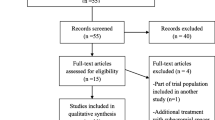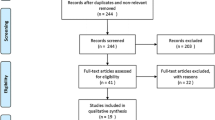Abstract
Purpose
To conduct a systematic review of outcomes following primary arthroscopic repair of chronic massive rotator cuff tears (RCTs) and to assess clinical outcomes and rates of repair failure. The authors’ preferred treatment algorithm is also provided.
Methods
Medline, Embase and PubMed were searched identifying articles pertaining to primary arthroscopic repair of chronic massive RCTs without the use of augmentation. Primary outcomes were patient-reported outcomes and the secondary outcome was the rate of repair failure. Outcome data were pooled and presented as well as assessment of study methodological quality. Data from studies reporting similar outcome measures were pooled when possible, and mean differences alongside confidence intervals and p values were reported, where appropriate.
Results
Twenty-six studies (1405 participants) were included, with mean age of 62 years (range 52–69). The mean duration of symptoms pre-operatively was 31 months (range 6–40), and the mean follow-up time was 39 months (range 12–111). Complete repair was performed in 78% of patients and partial repair was performed in 22%. Both complete and partial repairs resulted in significant improvements with respect to pain, range of motion and functional outcome scores. The rate of repair failure for the total cohort was 36% at a mean follow-up of 31 months, and for the complete and partial repair subgroups the failure rate was 35% and 40%, respectively.
Conclusions
Arthroscopic repairs of chronic, massive RCTs, whether complete or partial, are associated with significant improvements in pain, function and objective outcome scores. The rate of repair failure is lower than previously reported, however, still high at 36%. The present paper finds that arthroscopic repair is still a viable treatment option for massive RCTs.
Level of evidence
IV.


Similar content being viewed by others
References
Antuna S, Barco R, Martinez JM, Marquez JMS (2013) Platelet-rich fibrin in arthroscopic repair of massive rotator cuff tears: a prospective randomized pilot clinical trial. Acta Orthop Belg 79:25–30
Arrigoni P, Fossati C, Zottarelli L, Ragone V, Randelli P (2013) Functional repair in massive immobile rotator cuff tears leads to satisfactory quality of living: results at 3-year follow-up. Musculoskelet Surg 97(Suppl 1):73–77
Bartl C, Kouloumentas P, Holzapfel K, Eichhorn S, Wortler K, Imhoff A et al (2012) Long-term outcome and structural integrity following open repair of massive rotator cuff tears. Int J Shoulder Surg 6:1–8
Bennett WF (2003) Arthroscopic repair of massive rotator cuff tears: a prospective cohort with 2–4-year follow-up. Arthroscopy 19:380–390
Berth A, Neumann W, Awiszus F, Pap G (2010) Massive rotator cuff tears: functional outcome after debridement or arthroscopic partial repair. J Orthop Traumatol 11:13–20
Buess E, Waibl B, Seidner R, Werlen S (2011) Outcome of arthroscopic rotator cuff repair in large tears: the exposed footprint. Acta Orthop Belg 77:743–750
Burkhart SS, Barth JR, Richards DP, Zlatkin MB, Larsen M (2007) Arthroscopic repair of massive rotator cuff tears with stage 3 and 4 fatty degeneration. Arthroscopy 23:347–354
Carbone S, Razzano C, Passaretti D, Mezzoprete R (2018) Arthroscopic single-row repair of massive potentially irreparable postero-superior cuff tear. Musculoskelet Surg 102:13–19
Cavalier M, Jullion S, Kany J, Grimberg J, Lefebvre Y, Oudet D et al (2018) Management of massive rotator cuff tears: prospective study in 218 patients. Orthop Traumatol Surg Res 104:S193–S197
Chen KH, Chiang ER, Wang HY, Ma HL (2017) Arthroscopic partial repair of irreparable rotator cuff tears: factors related to greater degree of clinical improvement at 2 years of follow-up. Arthroscopy 33:1949–1955
Cho NS, Yi JW, Rhee YG (2009) Arthroscopic biceps augmentation for avoiding undue tension in repair of massive rotator cuff tears. Arthroscopy 25:183–191
Chung SW, Kim JY, Kim MH, Kim SH, Oh JH (2013) Arthroscopic repair of massive rotator cuff tears: outcome and analysis of factors associated with healing failure or poor postoperative function. Am J Sports Med 41:1674–1683
Cvetanovich GL, Gowd AK, Liu JN, Nwachukwu BU, Cabarcas BC, Cole BJ et al (2019) Establishing clinically significant outcome after arthroscopic rotator cuff repair. J Shoulder Elb Surg 28:939–948
Denard PJ, Jiwani AZ, Ladermann A, Burkhart SS (2012) Long-term outcome of arthroscopic massive rotator cuff repair: the importance of double-row fixation. Arthroscopy 28:909–915
Denard PJ, Ladermann A, Jiwani AZ, Burkhart SS (2012) Functional outcome after arthroscopic repair of massive rotator cuff tears in individuals with pseudoparalysis. Arthroscopy 28:1214–1219
DeOreo JK, Cofield RH (1984) Results of a second attempt at surgical repair of a failed initial rotator-cuff repair. J Bone Jt Surg Am 66:563–567
Di Benedetto ED, Di Benedetto P, Fiocchi A, Beltrame A, Causero A (2017) Partial repair in irreparable rotator cuff tear: our experience in long-term follow-up. Acta Biomed 88:69–74
Fossati C, Arrigoni P, Ragone V, Pietro S, Banfi G, Randelli F et al (2014) How do massive immobile rotator cuff tears behave after arthroscopic interval slides? Comparison with mobile tears. Joints 2:66–70
Galatz LM, Ball CM, Teefey SA, Middleton WD, Yamaguchi K (2004) The outcome and repair integrity of completely arthroscopically repaired large and massive rotator cuff tears. J Bone Jt Surg Am 86:219–224
Gerber C, Fuchs B, Hodler J (2000) The results of repair of massive tears of the rotator cuff. J Bone Jt Surg Am 82:505–515
Hao Q, Devji T, Zeraatkar D, Wang Y, Qasim A, Siemieniuk RAC et al (2019) Minimal important differences for improvement in shoulder condition patient-reported outcomes: a systematic review to inform a BMJ rapid recommendation. BMJ Open 9:e028777
Henry P, Wasserstein D, Park S, Dwyer T, Chahal J, Slobogean G et al (2015) Arthroscopic repair for chronic massive rotator cuff tears: a systematic review. Arthroscopy 31:2472–2480
Heuberer PR, Kolblinger R, Buchleitner S, Pauzenberger L, Laky B, Auffarth A et al (2016) Arthroscopic management of massive rotator cuff tears: an evaluation of debridement, complete, and partial repair with and without force couple restoration. Knee Surg Sports Traumatol Arthrosc 24:3828–3837
Itoi E, Minagawa H, Sato K, Tabata S (1997) Isokinetic strength after tears of the supraspinatus tendon. J Bone Jt Surg Br 79:77–82
Kim SJ, Choi YR, Jung M, Lee W, Chun YM (2017) Arthroscopic repair of anterosuperior massive rotator cuff tears: does repair integrity affect outcomes? Am J Sports Med 45:1762–1768
Kim SJ, Choi YR, Jung M, Lee WY, Chun YM (2017) Isolated subscapularis repair in irreparable posterosuperior massive rotator cuff tears involving the subscapularis tendon. Am J Sports Med 45:1269–1275
Kukkonen J, Kauko T, Vahlberg T, Joukainen A, Aarimaa V (2013) Investigating minimal clinically important difference for constant score in patients undergoing rotator cuff surgery. J Shoulder Elb Surg 22:1650–1655
Lam F, Mok D (2004) Open repair of massive rotator cuff tears in patients aged 65 years or over: is it worthwhile? J Shoulder Elb Surg 13:517–521
Lee E, Bishop JY, Braman JP, Langford J, Gelber J, Flatow EL (2007) Outcomes after arthroscopic rotator cuff repairs. J Shoulder Elb Surg 16:1–5
Lee SH, Nam DJ, Kim SJ, Kim JW (2017) Comparison of clinical and structural outcomes by subscapularis tendon status in massive rotator cuff tear. Am J Sports Med 45:2555–2562
Mellado JM, Calmet J, Olona M, Esteve C, Camins A, Perez del Palomar L et al (2004) Surgically repaired massive rotator cuff tears: MRI of tendon integrity, muscle fatty degeneration, and muscle atrophy correlated with intraoperative and clinical findings. AJR Am J Roentgenol 184:1456–1463
Novi M, Kumar A, Paladini P, Porcellini G, Merolla G (2018) Irreparable rotator cuff tears: challenges and solutions. Orthop Res Rev 10:93–103
Noyes MP, Ladermann A, Denard PJ (2017) Functional outcome and healing of large and massive rotator cuff tears repaired with a load-sharing rip-stop construct. Arthroscopy 33:1654–1658
Ok HS, Kim BG, Choi WC, Hong CG, Kim JW, Kim JH (2017) Clinical relevance of classifying massive rotator cuff tears: results based on functional and radiological findings after arthroscopic repair. Am J Sports Med 45:157–166
Park JY, Siti HT, Keum JS, Moon SG, Oh KS (2010) Does an arthroscopic suture bridge technique maintain repair integrity? A serial evaluation by ultrasonography. Clin Orthop Relat Res 468:1578–1587
Porcellini G, Castagna A, Cesari E, Merolla G, Pellegrini A, Paladini P (2011) Partial repair of irreparable supraspinatus tendon tears: clinical and radiographic evaluations at long-term follow-up. J Shoulder Elb Surg 20:1170–1177
Saupe N, Pfirrmann CW, Schmid MR, Jost B, Werner CM, Zanetti M (2006) Association between rotator cuff abnormalities and reduced acromiohumeral distance. AJR Am J Roentgenol 187:376–382
Simovitch R, Flurin PH, Wright T, Zuckerman JD, Roche CP (2018) Quantifying success after total shoulder arthroplasty: the minimal clinically important difference. J Shoulder Elb Surg 27:298–305
Taniguchi N, Suenaga N, Oizumi N, Miyoshi N, Araki N, Chosa E (2014) Surface-holding repair: an original arthroscopic rotator cuff repair technique. J Shoulder Elb Surg 23:620–627
Tashjian RZ, Deloach J, Green A, Porucznik CA, Powell AP (2010) Minimal clinically important differences in ASES and simple shoulder test scores after nonoperative treatment of rotator cuff disease. J Bone Jt Surg Am 92:296–303
Tempelaere C, Desmoineaux P, Lespagnol F, Pierrart J, Beaufils P, Pujol N (2017) Surgical repair of massive rotator cuff tendon tears: autologous quadriceps tendon graft versus arthroscopic repair. Orthop Traumatol Surg Res 103:435–440
van de Water AT, Shields N, Davidson M, Evans M, Taylor NF (2014) Reliability and validity of shoulder function outcome measures in people with a proximal humeral fracture. Disabil Rehabil 36:1072–1079
van der Zwaal P, Pool LD, Hacquebord ST, van Arkel ER, van der List MP (2012) Arthroscopic side-to-side repair of massive and contracted rotator cuff tears using a single uninterrupted suture: the shoestring bridge technique. Arthroscopy 28:754–760
Wang E, Wang L, Gao P, Li Z, Zhou X, Wang S (2015) Single-versus double-row arthroscopic rotator cuff repair in massive tears. Med Sci Monit 21:1556–1561
Wellmann M, Lichtenberg S, da Silva G, Magosch P, Habermeyer P (2013) Results of arthroscopic partial repair of large retracted rotator cuff tears. Arthroscopy 29:1275–1282
Yamamoto A, Takagishi K, Osawa T, Yanagawa T, Nakajima D, Shitara H et al (2010) Prevalence and risk factors of a rotator cuff tear in the general population. J Shoulder Elb Surg 19:116–120
Yokoya S, Nakamura Y, Harada Y, Ochi M, Adachi N (2019) Outcomes of arthroscopic rotator cuff repair with muscle advancement for massive rotator cuff tears. J Shoulder Elb Surg 28:445–452
Yoo JC, Ahn JH, Koh KH, Lim KS (2009) Rotator cuff integrity after arthroscopic repair for large tears with less-than-optimal footprint coverage. Arthroscopy 25:1093–1100
Author information
Authors and Affiliations
Corresponding author
Ethics declarations
Conflict of interest
The authors have no conflicts of interest.
Funding
There is no funding declare.
Ethical approval
Ethics approval was not required for this systematic review.
Additional information
Publisher's Note
Springer Nature remains neutral with regard to jurisdictional claims in published maps and institutional affiliations.
Electronic supplementary material
Below is the link to the electronic supplementary material.
Rights and permissions
About this article
Cite this article
Haleem, A., Gohal, C., Leroux, T. et al. Primary arthroscopic repair of massive rotator cuff tears results in significant improvements with low rate of re-tear. Knee Surg Sports Traumatol Arthrosc 29, 2134–2142 (2021). https://doi.org/10.1007/s00167-020-06190-3
Received:
Accepted:
Published:
Issue Date:
DOI: https://doi.org/10.1007/s00167-020-06190-3




